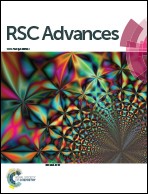Influence of interface properties on charge density, band edge shifts and kinetics of the photoelectrochemical process in p-type NiO photocathodes†
Abstract
Nickel oxide as one of the few p-type semiconductors has great potential applications in the construction of photovoltaics and solar fuel production devices. The present work focuses on understanding the surface structure of NiO by controlling the surface Ni3+ species (e.g. NiO(OH)) that influence the electrochemical process at the NiO/liquid electrolyte interface. With the aid of the Mott–Schottky method, electrochemical impedance spectroscopy and photocurrent–voltage correlation testing, various NiO surface structures were correlated with observed changes in the band energies, energetic distributions of the trap states densities, charge interface transfer, charge transport, and as a result the p-type DSSC device performances. The primary results demonstrate that the NiO(OH) species act as recombination centers and cause worse interface recombination. Furthermore, we also report an effective way of reducing the surface NiO(OH) structures by a Ni(CH3COOH)2 post-treatment method, resulting in a 31.3% increase in the photovoltaic performance. Our work provides good guidance for the design and fabrication of solar energy-related devices employing NiO electrodes.


 Please wait while we load your content...
Please wait while we load your content...